algorithm-homework
Algorithms Chapter 1 绪论

怎么处理?
30
The Design and Analysis of Algorithms
Chapter 1 Introduction to Algorithms
What’s an Algorithm?
算法是一系列解决问题的清晰指令,也就是说,能够对 一定规范的输入,在有限时间内获得所要求的输出。
16
The Design and Analysis of Algorithms
算法可以解决哪些问题
找出人类DNA中所有100000种基因,确定构成人类DNA的30亿种化学基 17 对的各种序列。
The Design and Analysis of Algorithms
算法可以解决哪些问题
快速访问和检索互联网数据
The Design and Analysis of Algorithms
例子
• “贝格尔”编排法(Beiger Arrangement) 把参赛队数分一半(参赛队为单数时,最后以“0” 表示形成双数),前一半由1号开始,自上而下写在 左边;后一半的数自下而上写在右边,然后用横线 把相对的号数连接起来。这即是第一轮的比赛。 第二轮将第一轮右上角的编号(“0”或最大的一个代 号数)移到左角上,第三轮又移到右角上,以此类推。 即单数轮次时“0”或最大的一个代号在右上角,双 数轮次时则在左上角。
//使用欧几里得算法计算gcd(m,n) //输入:两个不全为0的非负整数m,n //输出:m,n的最大公约数
28
The Design and Analysis of Algorithms
例子
• “贝格尔”编排法(Beiger Arrangement)
这种编排方法是否完美?
计算机专业英语作业

计算机专业英语作业:1、请将视频“什么是电脑硬件”中所述内容用英文表示。
2、请将以下英文翻译为中文。
1)Plug and Play, sometimes, abbreviated(简略的、缩写) PnP, is a catchy(动人的、易记住的) phrase( [freiz] 短语、习语) used to describe devices(设备、装备) that work with a computer system as soon as(与……一样)they are connected(链接的、有关系的). The user does not have to manually(手动的、用手) install drivers(驱动) for the device(装置、策略) or even tell the computer that a new device has been added. Instead the computer automatically(自动的、机械的) recognizes the device, loads new drivers for the hardware if needed, and begins to work with the newly connected device(链接设备),即插即用,缩写为PnP,这是一个容易记住的短语,它用来描述与计算机操作系统连接工作有关的设备。
用户不需要为设备手动安装驱动,甚至于不需要告诉计算机已经添加了饿一个新的设备。
计算机自动识别设备,如果需要为硬件加载一个新的驱动,并且开始工作在新的连接设备上。
For example, if you connect a Plug-and-Play mouse to the USB port on your computer, it will begin to work within a few seconds of being plugged(拥塞的、接通电源) in. A non plug-and-play device would require you to go through several steps of installing drivers and setting up the device before it would work.例如,如果你在你的电脑上的USB接口连接了一个即插即用的鼠标,它开始工作时接通电源只需要几秒钟。
homework12

1. a. b.2.3.4. 1. 2. 1. 2. Homework 12Programming in binary machine language1. Register manipulationCopy a value from register R2 into register R3 usingOnly one ADD instructionOnly one AND instructionClear value of register R5 using only one instructionUsing only one instruction, increment value in register R6 by 1.Using only one instruction, decrement value in register R5 by 2.2. Memory addressingUsing only one instruction, read value from memory located 20 memory locations away from the address stored in PC.Using only one instruction, generate and store in R5 address of a memory location 20 memory locations away from the current PC. Thendemonstrate how the address stored in R5 can be used to access memory at that address.3. Patt & Patel 6.4Systematically decompose the problem 6.4 from Patt & Patel textbook to the level of LC-3 instructions, then write LC-3 instructions to implement your solution. You may change the contents of R0, R1, and R2. Turn in your flow chart and LC-3 instructions in binary. For credit, each instruction must be annotated with a comment in RTL or assembly.4. 2nAssuming that R4 contains a positive value less than 15, put the value 2 into R3. You may change the contents of R3 and R4. Systematically R4decompose the problem to the level of LC-3 instructions, then write LC-3 instructions to implement your solution. Turn in your flow chart and LC-3 instructions in binary. For credit, each instruction must be annotated with a comment in RTL or assembly.5. Sum of sequenceAssuming that R5 contains a strictly positive number, compute the sum of integers from 1 to R5 and store the result in R2. You may change the contents of R2 and R5. Systematically decompose the problem to the level of LC-3 instructions, then write LC-3 instructions to implement your solution. Turn in your flow chart and LC-3 instructions in binary. For credit, each instruction must be annotated with a comment in RTL or assembly.6. Patt & Patel 6.16Solve problem 6.16 from Patt & Patel. Stop your execution trace when the PC reaches x3003, and do not fill in row x3003 of the table in your solution.7. Printing a lineTwo students are trying to print a line of periods bounded by asterisks to the console. The line is supposed to have N – 2 periods, where N 2. Forexample, when N = 8, they want to print, “” to the console (without quotes). Each student came up with a systematic decomposition that appears very *......*different from the other student's solution. Look at the two approaches, as represented by the flow charts below.Explain which approach is the better of the two and why you believe it to be better.Imagine that one must replace each box labeled “print ‘*’” with a complex algorithm requiring almost 1,000 LC-3 instructions toimplement. Repeat your comparison between the two approaches after the replacement described, again explaining why you believe your choiceto be the better one.Homework 12 is due on Wednesday, May 6, at the start of the lecture. Remember to include your (e.g.Discussions section ED1) andfollow the complete submission guidelines.Homework Please ask all questions about this assignment during the office hours, or post them on .piazza For your programs: write the instruction address, the binary LC-3 instruction, and the corresponding or assembly in the following format:RTL 0001 001 010 1 00100 ; R1 R2 + 40001 001 010 1 00100 ; ADD R1, R2, #4Note how .bits are arranged in groups that correspond to instruction-specific operands If you are not sure about the RTL format of a certain instruction, you can refer to Appendix A of your Patt & Patel text or read sections 5.5 and6.1. Try to make your program as simple and intuitive as you can.。
北航计算机研究生课程-算法设计与分析-HomeWork-1
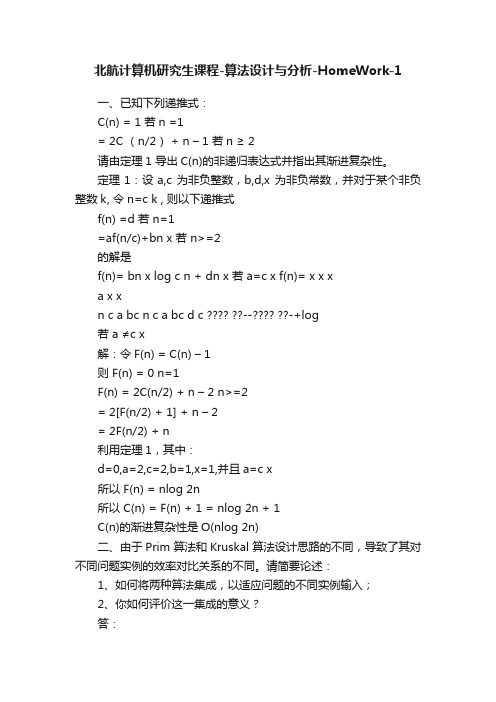
北航计算机研究生课程-算法设计与分析-HomeWork-1一、已知下列递推式:C(n) = 1 若n =1= 2C (n/2) + n – 1 若n ≥ 2请由定理1 导出C(n)的非递归表达式并指出其渐进复杂性。
定理1:设a,c 为非负整数,b,d,x 为非负常数,并对于某个非负整数k, 令n=c k , 则以下递推式f(n) =d 若 n=1=af(n/c)+bn x 若 n>=2的解是f(n)= bn x log c n + dn x 若 a=c x f(n)= x x xa x xn c a bc n c a bc d c ???? ??--???? ??-+log若a ≠c x解:令F(n) = C(n) – 1则 F(n) = 0 n=1F(n) = 2C(n/2) + n – 2 n>=2= 2[F(n/2) + 1] + n – 2= 2F(n/2) + n利用定理1,其中:d=0,a=2,c=2,b=1,x=1,并且a=c x所以 F(n) = nlog 2n所以 C(n) = F(n) + 1 = nlog 2n + 1C(n)的渐进复杂性是O(nlog 2n)二、由于Prim 算法和Kruskal 算法设计思路的不同,导致了其对不同问题实例的效率对比关系的不同。
请简要论述:1、如何将两种算法集成,以适应问题的不同实例输入;2、你如何评价这一集成的意义?答:1、Prim 算法基于顶点进行搜索,所以适合顶点少边多的情况。
Kruskal 从边集合中进行搜索,所以适合边少的情况。
根据输入的图中的顶点和边的情况,边少的选用kruskal 算法,顶点少的选用prim 算法2、没有一个算法是万能的,没有一个算法是对所有情况都适合的。
这一集成体现了针对具体问题选用最适合的方法,即具体问题具体分析的哲学思想。
三、分析以下生成排列算法的正确性和时间效率:HeapPermute (n )//实现生成排列的Heap 算法//输入:一个正正整数n和一个全局数组A[1..n]//输出:A中元素的全排列if n = 1write Aelsefor i ←1 to n doHeapPermute(n-1)if n is oddswap A[1]and A[n]else swap A[i]and A[n]解:n=1时,输出a1n=2时,输出a1a2,a2a1n=3时,(1)第一次循环i=1时,HeapPermute(2)将a1a2做完全排列输出,记为[a1a2]a3,并将A变为a2a1a3,并交换1,3位,得a3a1a2(2)第二次循环i=2时,HeapPermute(2)输出[a3a1]a2,并将A 变为a1a3a2,交换1,3位,得a2a3a1(3)第三次循环i=3时,HeapPermute(2)输出[a2a3]a1,并将A 变为a3a2a1,交换1,3位,得a1a2a3,即全部输出完毕后数组A回到初始顺序。
编程术语英语翻译

编程术语英语翻译abstract['æbstrækt] 抽象的抽象的abstraction 抽象体、抽象物、抽象性抽象体、抽象物、抽象性access['ækses, ] 存取、取用存取、访问access level 存取级别访问级别access function['fʌŋkʃən]存取函式访问函数activate ['æktiveit]活化激活active 作用中的adapter [ə'dæptə]配接器适配器address 位址地址address space 位址空间,定址空间address-of operator ['ɔpəreitə]取址运算子取地址操作符aggregation [,æɡri'ɡeiʃən] 聚合algorithm ['ælɡəriðəm]演算法算法allocate ['æləukeit] 配置分配allocator (空间)配置器分配器application [,æpli'keiʃən]应用程式应用、应用程序application framework['freimwə:k] 应用程式框架、应用框架应用程序框架architecture ['ɑ:kitektʃə] 架构、系统架构体系结构argument ['ɑ:ɡjumənt]引数(传给函式的值)。
叁见parameter [pə'ræmitə]叁数、实质叁数、实叁、自变量array [ə'rei]阵列数组arrow operator arrow(箭头)运算子箭头操作符assembly 装配件assembly language 组合语言汇编语言assert(ion) 断言assign 指派、指定、设值、赋值赋值assignment 指派、指定赋值、分配assignment operator 指派(赋值)运算子= 赋值操作符associated [ə'səuʃi,eitid]相应的、相关的相关的、关联、相应的associative [ə'səuʃjətiv]container[kən'teinə] 关联式容器(对应sequential container)关联式容器atomic 不可分割的原子的attribute[ə'tribju:t] 属性属性、特性audio ['ɔ:diəu]音讯音频A.I. 人工智慧人工智能background 背景背景(用於图形着色)後台(用於行程)backward compatible [kəm'pætəbl] 回溯相容向下兼容bandwidth ['bændwidθ] 频宽带宽base class 基础类别基类base type 基础型别(等同於base class)batch [bætʃ] 批次(意思是整批作业)批处理benefit 利益收益best viable ['vaiəbl]function 最佳可行函式最佳可行函式(从viable functions 中挑出的最佳吻合者)binary ['bainəri] search 二分搜寻法二分查找binary tree 二元树二叉树binary function 二元函式双叁函数binary operator 二元运算子二元操作符binding['baindiŋ] 系结绑定bit 位元位bit field ['fi:ld]位元栏位域bitmap ['bit,mæp]位元图位图bitwise 以bit 为单元逐一┅bitwise copy 以bit 为单元进行复制;位元逐一复制位拷贝block [blɔk]区块,区段块、区块、语句块boolean ['bu:liən]布林值(真假值,true 或false)布尔值border ['bɔ:də] 边框、框线边框brace[breis](curly['kə:li] brace) 大括弧、大括号花括弧、花括号bracket ['brækit] (square [skwεə] brakcet) 中括弧、中括号方括弧、方括号breakpoint 中断点断点build 建造、构筑、建置(MS 用语)build-in 内建内置bus 汇流排总线business 商务,业务业务buttons 按钮按钮byte [bait]位元组(由8 bits 组成)字节cache[kæʃ] 快取高速缓存call 呼叫、叫用调用callback 回呼回调call operator call(函式呼叫)运算子调用操作符(同function call operator)candidate ['kændideit, -dət] function 候选函式候选函数(在函式多载决议程序中出现的候选函式)chain 串链(例chain of function calls)链character ['kærəktə字元字符check box 核取方块(i.e. check button) 复选框checked exception 可控式异常(Java)check button 方钮(i.e. check box) 复选按钮child class 子类别(或称为derived class, subtype)子类class 类别类class body 类别本体类体class declaration [,deklə'reiʃən] 类别宣告、类别宣告式类声明class definition[,defi'niʃən] 类别定义、类别定义式类定义class derivation[,deri'veiʃən] list [list] 类别衍化列类继承列表class head 类别表头类头class hierarchy['haiə,rɑ:ki] 类别继承体系, 类别阶层类层次体系class library 类别程式库、类别库类库class template ['templit] 类别模板、类别范本类模板class template partial ['pɑ:ʃəl] specializations[,speʃəlai'zeiʃən]类别模板偏特化类模板部分特化class template specializations类别模板特化类模板特化cleanup 清理、善後清理、清除client['klaiənt] 客端、客户端、客户客户client-server 主从架构客户/服务器clipboard['klipbɔ:d] 剪贴簿剪贴板clone 复制克隆collection 群集集合combo ['kɔmbəu] box 复合方块、复合框组合框command line 命令列命令行(系统文字模式下的整行执行命令)communication [kə,mju:ni'keiʃən] 通讯通讯compatible [kəm'pætəbl]相容兼容compile[kəm'pail] time 编译期编译期、编译时compiler[kəm'pailə] 编译器编译器component[kəm'pəunənt] 组件组件composition [,kɔmpə'ziʃən] 复合、合成、组合组合computer 电脑、计算机计算机、电脑concept ['kɔnsept] 概念概念concrete [kən'kri:t, 'kɔnkri:t]具象的实在的concurrent[kən'kʌrənt] 并行并发configuration[kən,fiɡju'reiʃən] 组态配置connection 连接,连线(网络,资料库)连接constraint [kən'streint] 约束(条件)construct [kən'strʌkt] 构件构件container[kən'teinə] 容器容器(存放资料的某种结构如list, vector...)containment [kən'teinmənt] 内含包容context['kɔntekst] 背景关系、周遭环境、上下脉络环境、上下文control 控制元件、控件控件console [kən'səul]主控台控制台const 常数(constant['kɔnstənt] 的缩写,C++ 关键字)constant 常数(相对於variable ['vεəriəbl] )常量constructor(ctor)建构式构造函数(与class 同名的一种member functions)copy (v) 复制、拷贝拷贝copy (n) 复件, 副本cover 涵盖覆盖create 创建、建立、产生、生成创建creation 产生、生成创建cursor ['kə:sə] 游标光标custom 订制、自定定制data['deitə] 资料数据database 资料库数据库database schema ['ski:mə] 数据库结构纲目data member 资料成员、成员变数数据成员、成员变量data structure 资料结构数据结构datagram 资料元数据报文dead lock 死结死锁debug [di:'bʌɡ] 除错调试debugger [di:'bʌɡə]除错器调试器declaration[,deklə'reiʃən] 宣告、宣告式声明deduction[di'dʌkʃən] 推导(例:template ['templit] argument deduction)推导、推断default[di'fɔ:lt] 预设缺省、默认defer [di'fə:] 延缓推迟define[di'fain] 定义预定义definition[,defi'niʃən] 定义、定义区、定义式定义delegate'[deliɡeit] 委派、委托、委任委托delegation (同上)demarshal 反编列散集dereference 提领(取出指标所指物体的内容)解叁考dereference operator dereference(提领)运算子* 解叁考操作符derived[di'raivd] class 衍生类别派生类design by contract [ kən'trækt] 契约式设计design pattern ['pætən]设计范式、设计样式设计模式※最近我比较喜欢「设计范式」一词destroy [di'strɔi] 摧毁、销毁destructor[di'strʌktə] 解构式析构函数device[di'vais] 装置、设备设备dialog ['daiəlɔɡ] 对话窗、对话盒对话框directive [di'rektiv] 指令(例:using directive)(编译)指示符directory [di'rektəri] 目录目录disk [disk] 碟盘dispatch [dis'pætʃ] 分派分派distributed [di'stribjutid] computing[kəm'pju:tiŋ] 分布式计算(分布式电算) 分布式计算分散式计算(分散式电算)document [ dɔkjument] 文件文档dot [dɔt]基本翻译n. 点,圆点;嫁妆vi. 打上点vt. 加小点于dot [dɔt] operator dot(句点)运算子. (圆)点操作符driver [draivə] 驱动程式驱动(程序)dynamic [dai'næmik] binding ['baindiŋ] 动态系结动态绑定efficiency[i'fiʃənsi] 效率效率efficient [i'fiʃənt] 高效高效end user 终端用户entity['entəti] 物体实体、物体encapsulation [in,-kæpsə'leiʃən] 封装封装enclosing class 外围类别(与巢状类别nested class 有关)外围类enum (enumeration [i,nju:mə'reiʃən]) 列举(一种C++ 资料型别)枚举enumerators [i,nju:mə'reiʃən] 列举元(enum 型别中的成员)枚举成员、枚举器equal 相等相等equality[i:'kwɔləti] 相等性相等性equality operator equality(等号)运算子== 等号操作符equivalence [i'kwivələns] 等价性、等同性、对等性等价性equivalent 等价、等同、对等等价escape [i'skeip] code 转义码转义码evaluate [i'væljueit] 评估、求值、核定评估event 事件事件event driven 事件驱动的事件驱动的exception [ik'sepʃən] 异常情况异常exception declaration [,deklə'reiʃən] 异常宣告(ref. C++ Primer 3/e, 11.3)异常声明exception handling ['hændliŋ] 异常处理、异常处理机制异常处理、异常处理机制exception specification [,spesifi'keiʃən]异常规格(ref. C++ Primer 3/e, 11.4)异常规范exit 退离(指离开函式时的那一个执行点)退出explicit [ik'splisit] 明白的、明显的、显式显式export [ik'spɔ:t,] 汇出引出、导出expression [ik'spreʃən] 运算式、算式表达式facility [fə'siliti] 设施、设备设施、设备feature ['fi:tʃə] 特性field 栏位,资料栏(Java)字段, 值域(Java)file['fail] 档案文件firmware['fə:mwεə] 韧体固件flag[flæɡ] 旗标标记flash memory 快闪记忆体闪存flexibility [,fleksi'biliti] 弹性灵活性flush [flʌʃ] 清理、扫清刷新font [fɔnt] 字型字体form 表单(programming 用语)窗体formal ['fɔ:məl] parameter[pə'ræmitə] 形式叁数形式叁数forward declaration 前置宣告前置声明forwarding 转呼叫,转发转发forwarding function 转呼叫函式,转发函式转发函数fractal['fræktəl] 碎形分形framework 框架框架full specialization 全特化(ref. partial specialization)function 函式、函数函数function call operator 同call operatorfunction object 函式物件(ref. C++ Primer 3/e, 12.3)函数对象function overloaded resolution [,rezə'lu:ʃən]函式多载决议程序函数重载解决(方案)functionality [,fʌŋkʃə'næliti] 功能、机能功能function template 函式模板、函式范本函数模板functor ['fʌŋktə] 仿函式仿函式、函子game 游戏游戏generate ['fʌŋktə] 生成generic [dʒi'nerik] 泛型、一般化的一般化的、通用的、泛化generic algorithm ['ælɡəriðəm] 泛型演算法通用算法getter (相对於setter) 取值函式global 全域的(对应於local)全局的global object 全域物件全局对象global scope [skəup] resolution operator全域生存空间(范围决议)运算子:: 全局范围解析操作符group 群组group box 群组方块分组框guard [ɡɑ:d] clause [klɔ:z] 卫述句(Refactoring, p250) 卫语句GUI 图形介面图形界面hand shaking ['ʃeikiŋ] 握手协商handle['hændl] 识别码、识别号、号码牌、权柄句柄handler ['hændlə] 处理常式处理函数hard-coded 编死的硬编码的hard-copy 硬拷图屏幕截图hard disk 硬碟硬盘hardware ['hɑ:dwεə] 硬体硬件hash[hæʃ] table 杂凑表哈希表、散列表header file ['fail] 表头档、标头档头文件heap[hi:p] 堆积堆hierarchy ['haiə,rɑ:ki] 阶层体系层次结构(体系)hook [huk] 挂钩钩子hyperlink ['haipəliŋk] 超链结超链接icon['aikɔn] 图示、图标图标IDE 整合开发环境集成开发环境identifier [ai'dentifaiə] 识别字、识别符号标识符if and only if 若且唯若当且仅当Illinois 伊利诺伊利诺斯image 影像图象immediate base 直接的(紧临的)上层base class。
计蒜课算法
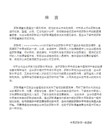
sum=max(0,sum); //如果求得sum<0,则将sum归零,从下一个元素开始求最大字段和;
smax = max(sum,smax); //将当前sum与原sum比较获取最大子段和
int n,maxi=0;
int a[maxn],m[maxn];
int dp[maxn];
void print(int x){
if(x) {
print(m[x]);
if(x!=maxi) cout<<a[x]<<" ";
else cout<<a[x]<<endl;
}
}
else{ //如果所有数都小于0;
for(int i = 0;i<n;i++){
smax=max(smax,a[i]);
int smax=-99999;
int main(){
cin>>n;
int a[n];
for(int i = 0;i<n;i++){
cin>>a[i];
}
if(yzs(a,n)){ //如果不是所有的数都小于0
for(int i = 0;i<n;i++){
{
dp[i]=dp[j]+1;
roud[i]=j;
}
}
if(dp[i]>dp[mmax])
{
mmax=i;
c[0][i]=0;
c[i][0]=0;
}
算法设计技巧与分析英文版课后练习题含答案

Algorithm Design Techniques and Analysis: English VersionExercise with AnswersIntroductionAlgorithms are an essential aspect of computer science. As such, students who are part of this field must master the art of algorithm design and analysis. Algorithm design refers to the process of creating algorithms that solve computational problems. Algorithm analysis, on the other hand, focuses on evaluating the resources required to execute those algorithms. This includes computational time and memory consumption.This document provides students with helpful algorithm design and analysis exercises. The exercises are in the formof questions with step-by-step solutions. The document is suitable for students who have completed the English versionof the Algorithm Design Techniques and Analysis textbook. The exercises cover various algorithm design techniques, such as divide-and-conquer, dynamic programming, and greedy approaches.InstructionEach exercise comes with a question and its solution. Read the question carefully and try to find a solution withoutlooking at the answer first. If you get stuck, look at the solution. Lastly, try the exercise agn without referring to the answer.Exercise 1: Divide and ConquerQuestion:Given an array of integers, find the maximum possible sum of a contiguous subarray.Example:Input: [-2, -3, 4, -1, -2, 1, 5, -3]Output: 7 (the contiguous subarray [4, -1, -2, 1, 5]) Solution:def max_subarray_sum(arr):if len(arr) ==1:return arr[0]mid =len(arr) //2left_arr = arr[:mid]right_arr = arr[mid:]max_left_sum = max_subarray_sum(left_arr)max_right_sum = max_subarray_sum(right_arr)max_left_border_sum =0left_border_sum =0for i in range(mid-1, -1, -1):left_border_sum += arr[i]max_left_border_sum =max(max_left_border_sum, left_b order_sum)max_right_border_sum =0right_border_sum =0for i in range(mid, len(arr)):right_border_sum += arr[i]max_right_border_sum =max(max_right_border_sum, righ t_border_sum)return max(max_left_sum, max_right_sum, max_left_border_s um+max_right_border_sum)Exercise 2: Dynamic ProgrammingQuestion:Given a list of lengths of steel rods and a corresponding list of prices, determine the maximum revenue you can get by cutting these rods into smaller pieces and selling them. Assume the cost of each cut is 0.Lengths: [1, 2, 3, 4, 5, 6, 7, 8]Prices: [1, 5, 8, 9, 10, 17, 17, 20]If the rod length is 4, the maximum revenue is 10.Solution:def max_revenue(lengths, prices, n):if n ==0:return0max_val =float('-inf')for i in range(n):max_val =max(max_val, prices[i] + max_revenue(length s, prices, n-i-1))return max_valExercise 3: Greedy AlgorithmQuestion:Given a set of jobs with start times and end times, find the maximum number of non-overlapping jobs that can be scheduled.Start times: [1, 3, 0, 5, 8, 5]End times: [2, 4, 6, 7, 9, 9]Output: 4Solution:def maximum_jobs(start_times, end_times):job_list =sorted(zip(end_times, start_times))count =0end_time =float('-inf')for e, s in job_list:if s >= end_time:count +=1end_time = ereturn countConclusionThe exercises presented in this document provide a practical way to master essential algorithm design and analysis techniques. Solving the problems without looking at the answers will expose students to the type of problems they might encounter in real life. The document’s solutionsprovide step-by-step instructions to ensure that students can approach the problems with confidence.。
常见常用英语名词短语大全
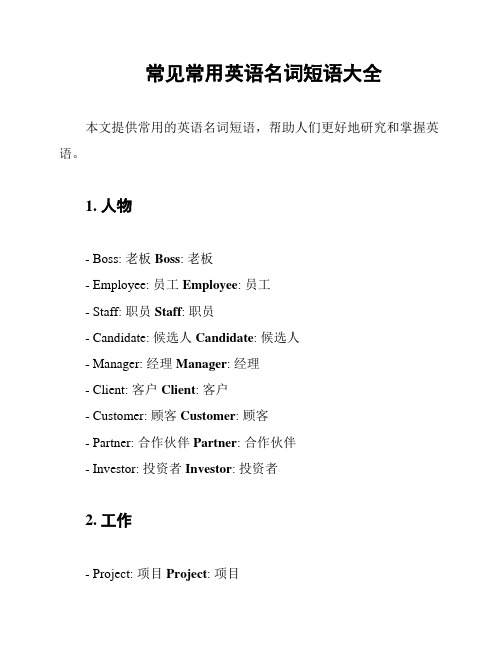
常见常用英语名词短语大全本文提供常用的英语名词短语,帮助人们更好地研究和掌握英语。
1. 人物- Boss: 老板Boss: 老板- Employee: 员工Employee: 员工- Staff: 职员Staff: 职员- Candidate: 候选人Candidate: 候选人- Manager: 经理Manager: 经理- Client: 客户Client: 客户- Customer: 顾客Customer: 顾客- Partner: 合作伙伴Partner: 合作伙伴- Investor: 投资者Investor: 投资者2. 工作- Project: 项目Project: 项目- Task: 任务Task: 任务- Meeting: 会议Meeting: 会议- Deadline: 截止日期Deadline: 截止日期- Schedule: 时间表Schedule: 时间表- Report: 报告Report: 报告- Budget: 预算Budget: 预算- Invoice: Invoice: 发票- Contract: 合同Contract: 合同3. 生活- Family: 家庭Family: 家庭- Friend: 朋友Friend: 朋友- Partner: 伴侣Partner: 伴侣- Children: 孩子Children: 孩子- Parent: 父母Parent: 父母- Sibling: 兄弟姐妹Sibling: 兄弟姐妹- Pet: 宠物Pet: 宠物- Hobby: 爱好Hobby: 爱好- Travel: 旅行Travel: 旅行4. 教育- Degree: 学位Degree: 学位- Graduate: 毕业生Graduate: 毕业生- Undergraduate: 本科生Undergraduate: 本科生- Professor: 教授Professor: 教授- Teacher: 教师Teacher: 教师- Student: 学生Student: 学生- Classroom: 教室Classroom: 教室- Homework: 作业Homework: 作业- Textbook: 教科书Textbook: 教科书- Library: 图书馆Library: 图书馆5. 技术- Software: 软件Software: 软件- Hardware: 硬件Hardware: 硬件- Programmer: 程序员Programmer: 程序员- Developer: 开发人员Developer: 开发人员- Database: 数据库Database: 数据库- Algorithm: 算法Algorithm: 算法- Server: 服务器Server: 服务器- Client: 客户端Client: 客户端- Code: 代码Code: 代码- Bug: 缺陷Bug: 缺陷以上是常见常用英语名词短语大全。
2024北京西城九年级二模英语(教师版)

2024北京西城初三二模英语2024. 5本部分共33题, 共40分。
在每题列出的四个选项中, 选出最符合题目要求的一项。
一、单项填空(每题0. 5分, 共6分)从下面各题所给的 A、B、C、D四个选项中, 选择可以填入空白处的最佳选项。
1. Tom and Mike are very kind. We like _______ very much.A. himB. herC. usD. them2. We start our first class________ 8:00 in the morning.A. onB. inC. atD. for3. We have to hurry up, ________we will be late for the talent show.A. andB. butC. soD. or4. —Mum, may I go to the cinema this Saturday?—Of course you ________, but finish your homework first.A. mustB. canC. shouldD. might5. Technology has made our life _________ than before.A. ConvenientB. more convenientC. most convenientD. the most convenient6. —___________ are tickets for two adults and one child?—$15.A. How farB. How oftenC. How muchD. How soon7. Now, some of our classmates ________ basketball on the playground. Let's join them.A. are playingB. have playedC. were playingD. played8. We _______ for a picnic if the weather stays nice tomorrow.A. will goB. goC. have goneD. went9. Dad ________ dinner when I arrived home.A. CooksB. is cookingC. was cookingD. will cook10. My grandparents' hometown__________ a lot since they moved away.A. changesB. was changingC. will changeD. has changed11. The Dragon Boat Festival ________in late May or June every year.A. celebratesB. celebratedC. is celebratedD. was celebrated12. —I missed the last English class. Could you tell me __________ ?—Yes. We talked about world food culture.A. what did you discussB. what you discussedC. what are you going to discussD. what you are going to discuss二、完形填空(每题1分, 共8分)阅读下面的短文, 掌握其大意, 然后从短文后各题所给的A、B、C、D 四个选项中, 选择最佳选项。
designandanalysisofalgorithms算法设计与分析
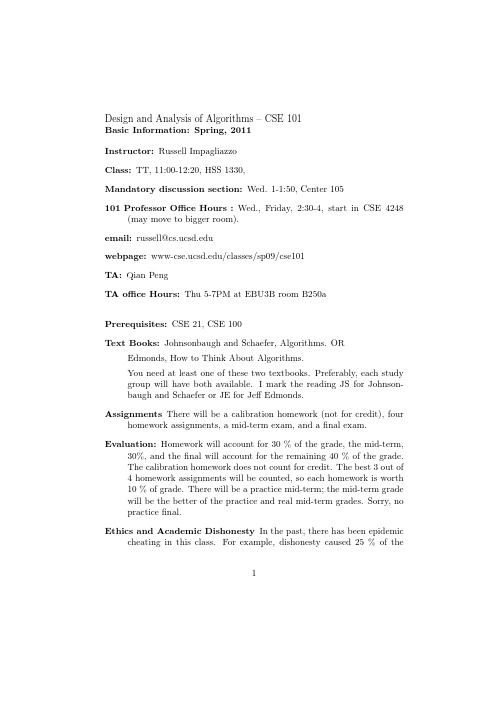
Design and Analysis of Algorithms–CSE101Basic Information:Spring,2011Instructor:Russell ImpagliazzoClass:TT,11:00-12:20,HSS1330,Mandatory discussion section:Wed.1-1:50,Center105101Professor Office Hours:Wed.,Friday,2:30-4,start in CSE4248 (may move to bigger room).email:***************.eduwebpage:/classes/sp09/cse101TA:Qian PengTA office Hours:Thu5-7PM at EBU3B room B250aPrerequisites:CSE21,CSE100Text Books:Johnsonbaugh and Schaefer,Algorithms.OREdmonds,How to Think About Algorithms.You need at least one of these two textbooks.Preferably,each study group will have both available.I mark the reading JS for Johnson-baugh and Schaefer or JE for JeffEdmonds.Assignments There will be a calibration homework(not for credit),four homework assignments,a mid-term exam,and afinal exam. Evaluation:Homework will account for30%of the grade,the mid-term, 30%,and thefinal will account for the remaining40%of the grade.The calibration homework does not count for credit.The best3out of 4homework assignments will be counted,so each homework is worth 10%of grade.There will be a practice mid-term;the mid-term grade will be the better of the practice and real mid-term grades.Sorry,no practicefinal.Ethics and Academic Dishonesty In the past,there has been epidemic cheating in this class.For example,dishonesty caused25%of the1class to fail in1997.For this reason,some rather intrusive rules have been instituted.Students will be allowed to solve and write up all homework assign-ments in groups of size up to4.All names should appear on the assignment.Members of a group are responsible for all parts of any assignment with their names on it.Problems should be solved by the group,not divided up between group members.Each member of a group should participate in discussions about each problem.The front page should be signed by each member of a group;this is interpretted as the state-ment:”I participated in discussion for each problem,and have read and understood the answers here,which are summaries of our discus-sion.”If this statement is true,just sign your name.If you wish to modify this statement,write and sign the modified statement instead. If the statement is not true of some of the problems,add”except for problems...”.You will not receive credit for these problems,but you also will not bear responsibility for them.Students should not look for answers to homework problems in other (i.e.,other than the course texts and class notes)texts or other sources (e.g.Internet discussion groups or newsgroups).However,students may use other texts as a general study tool,and may accidentally see solutions to homework problems.In this case,the student should write up thefinal solution without consulting this text or source,and should give an acknowledgement of the text or source on thefirst page of their solutions.Such a solution may be given partial or no credit if it too closely follows the source.Not giving an acknowledement is academic dishonesty,and will be treated as such.This rule applies to any material found on the internet,and to conversations with or written material from other people, whether or not they are students in the class.However,it does not apply to material handed out in class or on the class web-page for this year,or to conversations with the instructor or teaching assistants.Be sure to follow the following guidelines:1.Do not discuss problems with people outside your group(exceptduring office hours,or with the TAs or myself).22.Do not share written solutions or partial solutions with othergroups.3.Prepare yourfinal written solution without consulting any writ-ten material except class notes and the class text.4.Acknowledge all supplementary texts or sources that had solu-tions to homework problems.5.All problems should be discussed by the entire group. Standards for assignments Most assignments and exam problems will be mathematical or theoretical in nature,and will require you to prove your answer correct.Grading of all such problems(homework and exam)will be both on the basis of correctness and on logical consistency and completeness,i.e.,“mathematical style”.It is your obligation to provide a compelling argument that forces the reader to believe the result,not just notes from which an argument could be constructed.In particular,correct formulas or pseudo-code are nota complete solution by themselves;their significance and the logic oftheir application need to be explained.A typical assignment is to design an efficient algorithm for a givenproblem.When giving an algorithm,the following two things should always be included,unless the problem explicitly says not to:a cor-rectness argument,showing why the algorithm solves the problem;and a time analysis,giving the order of the worst-case runtime(in O-notation).One problem on each homework assignment will involve implementing an algorithm,and reporting time usage data on a variety of inputs (which will be either completely specified or specified as a distribution on random instances).This implementation may be done in any lan-guage,and be run on any machine.Your solution should only includea brief description of your program;in particular,we will not readactual code,so you needn’t hand it in.You should hand in only a description of your program,specifying the basic algorithm used,any modifications that you made to this algorithm,the language used,the performance characteristics of the machine used,and timing informa-tion for the various inputs you ran the program on.Discuss whether the timing results seemed consistent with the asymptotic analysis;if not,what in your opinion is the reason?The TA or I may ask to seea demonstration of your program on other instances.3Lateness Policy Late homework will be accepted until I give out an answer key and no later.So you have to be no later than me.I will also not accept homework after thefirst10minutes of the class it is due.Working on the homework is no excuse for missing class or not paying attention.Reading Schedule We will not be able to cover every example on each topic in the text in class.(JS=Johnsonbaugh and Shaeffer,required text;JE=JeffEdmonds’How to Think About Algorithms.)You are expected to read the other sub-sections independently.In particular, we will only quickly review the material in JE Chapter1=JS Ch.1,2.1-4and the basic data structures(JE Chapter2&3=JS Ch. 2.5,2.6,3).These should be familiar from CSE100and21,but will beused heavily in this class.Reading this material in advance is a good plan.To help you plan your reading,here is a tentative schedule of topics to be covered in class,and the corresponding sections of the text to be read.I reserve the option to change the schedule at a later point.You shouldfind most of the material in EITHER of:JS=Johnsonbaugh and Schaefer,Algorithms OR JE=JeffEdmonds,How To Think about Algorithms.(You don’t need to read both textbooks,but sometimes it may be helpful to see things explained in different ways.)1.Background:This is material we are only quickly reviewing.Youshould be familiar with this material from previous classes.Ifyou are having trouble with this material,you will need to workmuch harder throughout the course to keep up.Order notation,time analysis,recurrence relations:(JE Chapter1,JS Chapter2.3,2.4)Basic data structures:lists,arrays,graphs,trees stacks,heaps(JS:Chapters2.5,2.6,3JE:Chapters2and5.1).This ma-terial should be covered in CSE100and21.Read it and trysome exercises.If you have any problems,go back and read thechapter thoroughly.2.Basic iterative algorithms.Loop invariants and correctness proofs.Time analysis.(JE,Chapter3;JS pp37-38,section2.3).Exam-ples:Largest sum consecutive subarray;depth-first and breadth-first search(JS Ch4.2, 4.3,JE8.2,8.4),topological sort(JS:Chapter4.4,JE8.5).(2lectures).43.Maximizing Efficiency in Iterative ing restructur-ing,pre-processing and data structures to get the most efficientversions of algorithms.Graph and integer ingdata structures such as lists,arrays,heaps and balanced searchtrees.Sorting(JS,Chapter6),skylines,auction problem,maxi-mum min-degree subgraph.(2lectures).4.Greedy Algorithms(JE,Chapter10;JS,Chapter7)When do greedy algorithmswork?Proof techniques for optimality of greedy algorithms.Ex-amples:scheduling(JE,10.2.1);Minimum spanning trees(JS,7.2,7.3;JE,10.2.3);Dijkstra’s Algorithm(JS7.4;JE8.3);Inde-pendent set of a tree;others to be added.3lectures.5.Recursive algorithms and their analysis.Correctness proofs bystrong induction.Recurrence relations.(JE,Chapter5,6,JS2.4).Euclid’s GCD algorithm(JE,Chapter4.3),(1lectures.)6.Arithmetic and numerical algorithms.Euclid’s GCD algorithmrevisited.Amortized analysis of GCD.(1lecture)7.Divide-and-Conquer.(JS,Chapter5.)Examples:Mergesort(JS,5.2);Multiplicationof large integers;all distances in balanced binary tree;closestpair of points(JS,5.3);Quicksort(JS,6.2);The analysis of somedivide-and-conquer algorithms will require Lemma2.4.15of JS,which is also in Chapter1.6of JE.(3lectures.)8.Backtracking(JS,Chapter4.5,JE Chapter11)I spend more time on thisbecause Dynamic Programming can be viewed as a modificationof Backtracking.Examples:Independent set;n queens((JS4.5,JE11.2.3),graphcoloring,Hamiltonian Cycle(JS,4.5),and addition chains.2lectures.9.Dynamic Programming,(JS,Chapter8;JE Chapter12)Examples:Fibonnacci numbers(JS,8.1);Longest increasing sub-sequence;Shortest paths(JE12.2.7,JS8.5);Matrix Multiplication(JE,12.2.5,JS8.3);Editdistance=Longest Common subsequence(JE,12.2.2,JS,8.4);schedul-ing.3lectures.10.Reductions and NP-completeness5(JS,Ch10,11;JE,Ch.13)When can one type of problem“code”another;NP,a format for search problems;universal(NP-complete)search problems.Coping with intractibility.2lectures Assignment and Exam schedule To help you plan,here is the tentative assignment and exam schedule:1.April5:Calibration homework(order,recurrences,simple algo-rithm analysis and correctness)due2.April19:Homework1(efficient versions of algorithms)due3.April27:Discussion section:practice mid-term(order,solvingrecurrences,algorithm analysis and correctness,data structures,greedy algorithms)4.May3:homework2(greedy algorithms)due5.May11:discussion section:midterm(order,solving recurrences,algorithm analysis and correctness,data structures,greedy algo-rithms)6.May17,homework3(divide-and-conquer and back-tracking)due.7.June2,homework4(dynamic programming)due8.June7,Final exam.6。
实用英汉翻译教程答案

实用英汉翻译教程答案实用英汉翻译教程答案(中文)实用英汉翻译教程是一本针对英汉翻译初学者的教材,旨在帮助学习者提高英汉翻译的技能。
以下是一份500字的实用英汉翻译教程答案。
第一部分:词汇翻译1. 解释下列词汇的中文意思:- Keyboard: 键盘- Database: 数据库- Software: 软件- Algorithm: 算法- Dialogue: 对话2. 解释下列词汇的英文意思:- 中心: Center- 忠诚: Loyalty- 独立: Independent- 笔记本电脑: Laptop- 乡村: Rural第二部分:短语翻译1. 翻译下列短语:- How do you do?: 你好(问候语)- Break the ice: 打破僵局- Piece of cake: 小菜一碟- Go with the flow: 随遇而安- Keep an eye on: 注意第三部分:句子翻译1. 翻译下列句子:- I have a lot of work to do today.(我今天有很多工作要做。
)- Can you help me with my homework?(你能帮我做作业吗?)- She is studying for her exams.(她正在备考。
)- We went to the beach last weekend.(我们上周末去了海滩。
)- The dog is playing in the park.(那只狗在公园里玩耍。
)第四部分:段落翻译翻译以下段落:"In recent years, the use of artificial intelligence (AI) has become increasingly popular. AI technology has been applied in various fields, including healthcare, finance, and transportation. For example, AI-powered robots are now being used in hospitals to assist with patient care and surgery. AI algorithms are also used in financial institutions to analyze and predict market trends. In the transportation sector, self-driving cars are becoming more common, thanks to AI technology.The benefits of AI are undeniable, but there are also concerns about its potential risks. Some people worry that AI could replacehuman jobs, leading to unemployment. Others are concerned about the ethical implications of AI, such as privacy issues and biased decision-making. As AI continues to advance, it is essential to address these concerns and ensure that AI is used responsibly and ethically."近年来,人工智能(AI)的应用越来越普遍。
Algorithm算法库
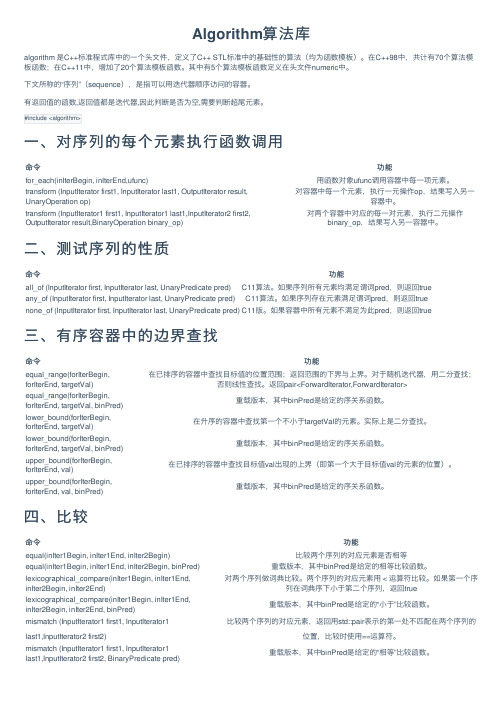
Algorithm算法库algorithm 是C++标准程式库中的⼀个头⽂件,定义了C++ STL标准中的基础性的算法(均为函数模板)。
在C++98中,共计有70个算法模板函数;在C++11中,增加了20个算法模板函数。
其中有5个算法模板函数定义在头⽂件numeric中。
下⽂所称的“序列”(sequence),是指可以⽤迭代器顺序访问的容器。
有返回值的函数,返回值都是迭代器,因此判断是否为空,需要判断超尾元素。
⼀、对序列的每个元素执⾏函数调⽤命令功能for_each(inIterBegin, inIterEnd,ufunc)⽤函数对象ufunc调⽤容器中每⼀项元素。
transform (InputIterator first1, InputIterator last1, OutputIterator result, UnaryOperation op)对容器中每⼀个元素,执⾏⼀元操作op,结果写⼊另⼀容器中。
transform (InputIterator1 first1, InputIterator1 last1,InputIterator2 first2, OutputIterator result,BinaryOperation binary_op)对两个容器中对应的每⼀对元素,执⾏⼆元操作binary_op,结果写⼊另⼀容器中。
⼆、测试序列的性质命令功能all_of (InputIterator first, InputIterator last, UnaryPredicate pred)C11算法。
如果序列所有元素均满⾜谓词pred,则返回true any_of (InputIterator first, InputIterator last, UnaryPredicate pred)C11算法。
如果序列存在元素满⾜谓词pred,则返回true none_of (InputIterator first, InputIterator last, UnaryPredicate pred)C11版。
写作业用的英语名词有哪些
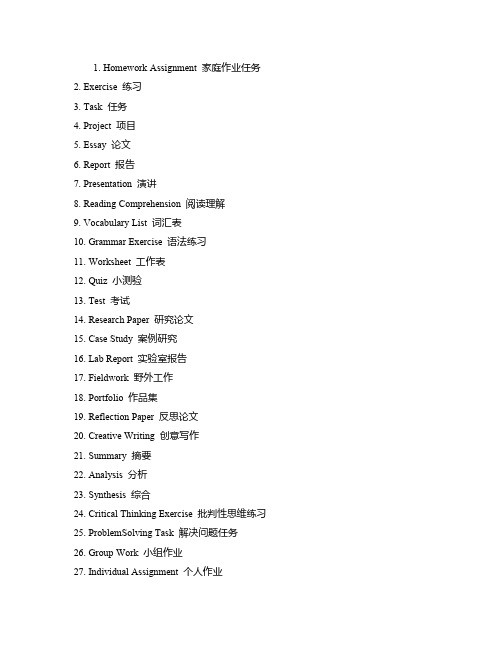
1.Homework Assignment家庭作业任务2.Exercise练习3.Task任务4.Project项目5.Essay论文6.Report报告7.Presentation演讲8.Reading Comprehension阅读理解9.Vocabulary List词汇表10.Grammar Exercise语法练习11.Worksheet工作表12.Quiz小测验13.Test考试14.Research Paper研究论文15.Case Study案例研究b Report实验室报告17.Fieldwork野外工作18.Portfolio作品集19.Reflection Paper反思论文20.Creative Writing创意写作21.Summary摘要22.Analysis分析23.Synthesis综合24.Critical Thinking Exercise批判性思维练习25.ProblemSolving Task解决问题任务26.Group Work小组作业27.Individual Assignment个人作业28.Class Participation课堂参与29.Online Assignment在线作业30.Peer Review同行评审31.Discussion Board Post讨论板帖子32.Blog Post博客帖子33.Tutorial教程34.Flashcard Set闪卡集35.Study Guide学习指南36.Outline大纲37.Annotated Bibliography注释书目38.Proposal建议书39.Thesis论文40.Dissertation博士论文41.Journal Entry日记条目42.Letter Writing信件写作43.Resume简历44.Cover Letter求职信45.Business Plan商业计划46.Script剧本47.Storyboard故事板48.Algorithm算法49.Code代码50.Data Analysis数据分析。
Homework2
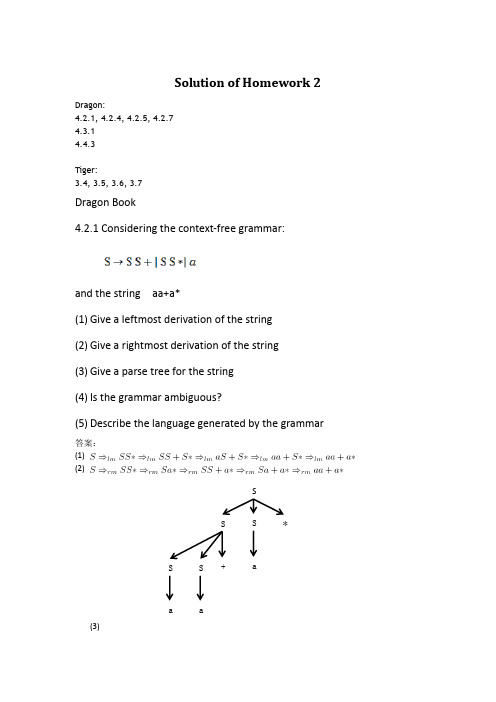
Solution of Homework 2Dragon:4.2.1, 4.2.4, 4.2.5, 4.2.74.3.14.4.3Tiger:3.4, 3.5, 3.6, 3.7Dragon Book4.2.1 Considering the context-free grammar:and the string aa+a*(1)Give a leftmost derivation of the string(2)Give a rightmost derivation of the string(3)Give a parse tree for the string(4)Is the grammar ambiguous?(5)Describe the language generated by the grammar答案:(1)(2)(3)SSS* S S+a aa(4)没有二义性(5)只含+和*,操作数均为a的算术表达式的后序遍历4.2.4 Show that [] and {} extension do not add power to grammars.答案: S->[a] 等价于S->S->{a} 等价于S->S’S’ -> ’4.2.5 Use notations from 4.2.4 to simplify the following grammar:答案:stmt-> if expr then stmt [else stmt]| begin stmtList endstmtList -> stmt{;stmt}4.2.7 A grammar symbol X (terminal or non-terminal) is useless if there is no derivation of the form . That is, X can neverappear in the derivation of any sentence.(1) Give an algorithm to eliminate all productions contains useless symbols(2) Apply your algorithm to grammar:S-> 0 | AA-> ABB->1答案:(1)注意:首先要考虑产生式是否终止,其次考虑是否在产生式中出现(a)求出非终结符是否终止对于每个非终结符X若X存在产生式不含非终结符,则X终止否则,对于X的每个产生式中的非终结符,若含有X,则X不终止,否则,若每个非终结符均终止,则X终止,否则不终止(b)去掉useless令文法G为空从起始的非终结符X开始对于X的每个产生式P,若P不含非终结符,则将X->P加入文法G否则,若P中每个非终结符均终止,则将X->P加入文法S’,并对每个非终结符X’递归调用这个过程返回文法G算法并不唯一,这只是一个很罗嗦的实现(2)对于这里给出的算法首先S和B终止,A不终止然后从S->0开始,S->0加入文法GS->A,A不终止,至此递归调用结束所以最终返回结果S->04.3.1 The following grammar for regular expressions over symbols a andb only.(1)Left factor this grammar(2)Does left factoring make the grammar suitable for top-down parsing?(3)Eliminate left recursion from the original grammar(4)Is the resulting grammar suitable for top-down parsing?答案:(1)rexpr -> rexpr + rterm | rtermrterm -> rterm rfactor | refactorrfactor -> rfactor * | rprimaryrprimary-> a| b(2)不可以,因为存在左递归(3)rexpr -> rterm rexpr’rexpr’-> + rterm rexpr’ |rterm-> rfactor rterm’rterm’ -> rfactor rterm’ |rfactor-> rprimay rfactor’rfactor’-> *rfactor’ |rprimary-> a | b(4)可以4.4.3 计算练习4.2.1中文法的FIRST和FOLLOW集合答案:FIRST(S)=aFOLLOW(S)= $a+*Tiger Book3.4 Write a grammar that accepts the same language as Grammar 3.1, but that us suitable for LL(1) parsing. That is, eliminate the ambiguity, eliminate the left recursion, and (if necessary) left-factor.Grammar 3.1:S -> S; SS -> id := ES -> print ( L )E -> idE -> numE -> E + EE -> ( S , E )L -> EL -> L , EAnswer:S -> id := E ; SS -> print ( L ) ; SE -> ( S , E )E -> id E’E -> num E’E’ -> εE’ -> + EL -> E L’L’ ->εL’ -> , E L’3.5 Find nullable, FIRST, and FOLLOW sets for the grammar; then construct the LL(1) parsing table.S’ -> S $S ->S -> X SB -> \ begin { WORD }E -> \ end { WORD }X -> B S EX -> { S }X -> WORDX -> beginX -> endX -> \ WORDAnswer:3.6a. Calculate nullable, FIRST, and FOLLOW for this grammar:S -> u B D zB -> B vB -> wD ->E FE -> yE ->F -> xF->b. Constructor the LL(1) parsing table.c. Give evidence that this grammar is not LL(1).d. Modify the grammar as little as possible to make an LL(1) grammar that accepts the same language.Answer:a)c) b中构建的LL(1)转换表中含有包含多个语法规则的表项,所以该语法不是LL(1)语法。
数学错题反思模板英语
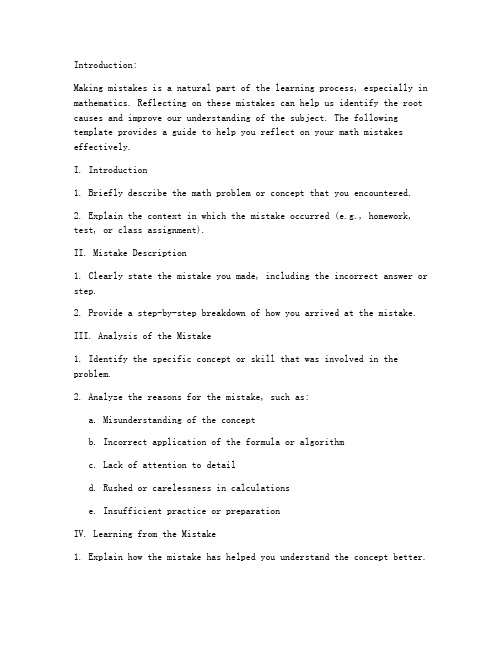
Introduction:Making mistakes is a natural part of the learning process, especially in mathematics. Reflecting on these mistakes can help us identify the root causes and improve our understanding of the subject. The following template provides a guide to help you reflect on your math mistakes effectively.I. Introduction1. Briefly describe the math problem or concept that you encountered.2. Explain the context in which the mistake occurred (e.g., homework, test, or class assignment).II. Mistake Description1. Clearly state the mistake you made, including the incorrect answer or step.2. Provide a step-by-step breakdown of how you arrived at the mistake.III. Analysis of the Mistake1. Identify the specific concept or skill that was involved in the problem.2. Analyze the reasons for the mistake, such as:a. Misunderstanding of the conceptb. Incorrect application of the formula or algorithmc. Lack of attention to detaild. Rushed or carelessness in calculationse. Insufficient practice or preparationIV. Learning from the Mistake1. Explain how the mistake has helped you understand the concept better.2. Discuss any new insights or strategies you have gained from the experience.3. Suggest ways to avoid similar mistakes in the future, such as:a. Reviewing the concept and practicing moreb. Taking your time and double-checking your workc. Seeking help from a tutor or teacherd. Developing a better understanding of the underlying principlesV. Action Plan1. Outline a plan to improve your understanding of the concept or skill.2. Include specific steps, such as:a. Reviewing the relevant textbook or online resourcesb. Solving similar problems to reinforce your understandingc. Setting aside dedicated time for practiced. Attending study groups or forming a study partnerVI. Conclusion1. Summarize the key points of your reflection.2. Reflect on the overall impact of the mistake on your learning process.3. Express your commitment to continuous improvement and dedication to mastering the subject.Example:I. IntroductionToday, I encountered a mistake while solving a geometry probleminvolving the area of a triangle. The problem was assigned as homework.II. Mistake DescriptionThe mistake I made was in calculating the base and height of the triangle. As a result, I arrived at an incorrect answer.III. Analysis of the MistakeThe mistake occurred due to a lack of attention to detail. I misunderstood the given information and incorrectly measured the base and height of the triangle.IV. Learning from the MistakeThis mistake has helped me understand the importance of paying close attention to the given information. I now realize that even a smallerror in measurement can lead to an incorrect answer. I plan to take my time and double-check my work in the future.V. Action PlanTo improve my understanding of geometry and avoid similar mistakes, I will:- Review the relevant section of my textbook.- Solve more geometry problems to practice my skills.- Dedicate time each day to practice and review the material.VI. ConclusionReflecting on this mistake has been an eye-opener for me. I am committed to continuous improvement and will work hard to master the subject of geometry.。
作业帮共建算法

作业帮共建算法随着近年来城市供电系统普及,算法作业帮(Algorithm Homework Help)也渐渐受到了广泛关注,成为学习者和工作者们完成算法题目和课程设计的工具。
算法作业帮是一个例子,它可以帮助学习者更轻松地完成算法题目和课程设计,同时也帮助老师更高效地完成任务,同时实现更多的计算机知识分享和发展。
然而,不少学习者在使用算法作业帮时遇到了一些问题:算法作业帮的知识储备不足,容易出错;算法作业帮的答案缺乏可验证过程,无法检验答案的正确性;复杂算法的答案缺乏相应的解释,困扰学习者的理解、应用能力。
为解决上述问题,作业帮推出了“共建算法”项目,旨在提升算法作业帮的知识储备,提供有效的验证过程,解释性的答案,帮助学习者更好地理解、应用算法,以及更加精准的完成课程设计。
“共建算法”项目的实施分为两个阶段:第一阶段,作业帮邀请计算机专家和有丰富算法知识、经验的学习者共同参与,贡献自己的算法知识和答案;第二阶段,作业帮将依据专家和学习者贡献的算法知识和解析,建立算法作业帮的知识库,并且专门招募算法教师在算法作业帮上进行指导、讲解和反馈,以保证答案的正确性和帮助学习者更加深入的理解算法问题的背后的原理。
在这个“共建算法”项目中,专家和学习者都可以发挥自己的作用,专家可以在知识储备和讲解方面贡献自己的力量,学习者可以通过不断的实践,逐步提升自己的算法理解能力,逐步掌握解决算法题目的技巧,更加深入地掌握算法思想,使用算法作业帮更加高效、安全地完成课程设计。
作业帮“共建算法”项目已经在很多大学、研究机构中推广,受到了学校、学生、老师们的高度评价,得到了广泛关注,得到了很多有价值的意见和建议。
作业帮“共建算法”项目致力于促进学习者理解算法的能力,有效地满足学习者的需求,在提升计算机科学的发展方面发挥着重要的作用。
综上所述,作业帮推出的“共建算法”项目无疑是一个重要的创新,它可以解决现有算法作业帮中存在的一些问题,为学习者提供更安全、更有效的算法解决方案,以及更多的知识分享和发展的机会。
algorithm-homework
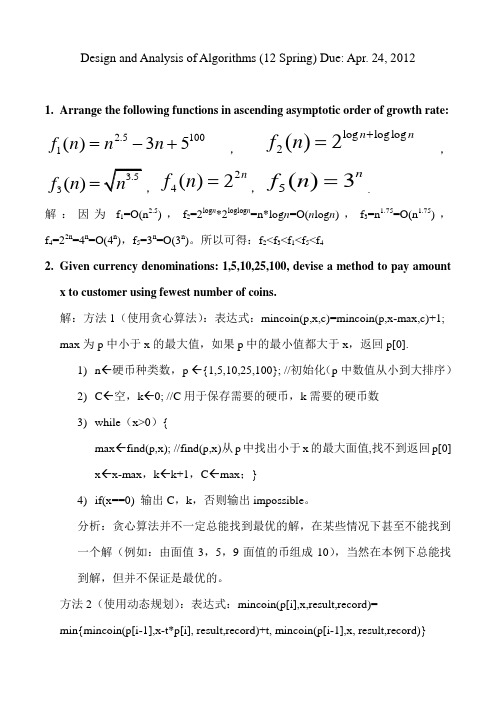
Design and Analysis of Algorithms (12 Spring) Due: Apr. 24, 20121. Arrange the following functions in ascending asymptotic order of growth rate:2.51001()35f n nn =-+,log loglog 2()2n nf n +=,3()f n =,24()2nf n =,5()3n f n =.解:因为f 1=O(n 2.5),f 2=2log n *2loglog n =n*log n =O(n log n ),f 3=n 1.75=O(n 1.75),f 4=22n =4n =O(4n ),f 5=3n =O(3n )。
所以可得:f 2<f 3<f 1<f 5<f 42. Given currency denominations: 1,5,10,25,100, devise a method to pay amount x to customer using fewest number of coins.解:方法1(使用贪心算法):表达式:mincoin(p,x,c)=mincoin(p,x-max,c)+1; max 为p 中小于x 的最大值,如果p 中的最小值都大于x ,返回p[0]. 1) n ←硬币种类数, p ←{1,5,10,25,100}; //初始化(p 中数值从小到大排序) 2) C ←空,k ←0; //C 用于保存需要的硬币,k 需要的硬币数 3) while (x>0){max ←find(p,x); //find(p,x)从p 中找出小于x 的最大面值,找不到返回p[0] x ←x-max ,k ←k+1,C ←max ;}4) if(x==0) 输出C ,k ,否则输出impossible 。
USC算法导论作业3
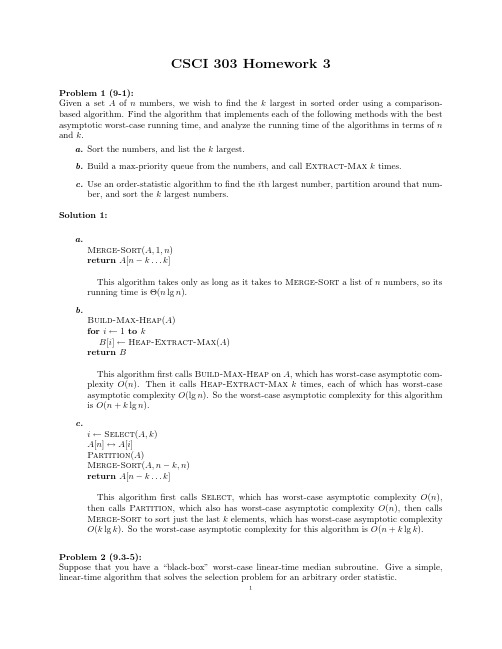
CSCI303Homework3Problem1(9-1):Given a set A of n numbers,we wish tofind the k largest in sorted order using a comparison-based algorithm.Find the algorithm that implements each of the following methods with the best asymptotic worst-case running time,and analyze the running time of the algorithms in terms of n and k.a.Sort the numbers,and list the k largest.b.Build a max-priority queue from the numbers,and call Extract-Max k times.e an order-statistic algorithm tofind the i th largest number,partition around that num-ber,and sort the k largest numbers.Solution1:a.Merge-Sort(A,1,n)return A[n−k...k]This algorithm takes only as long as it takes to Merge-Sort a list of n numbers,so its running time isΘ(n lg n).b.Build-Max-Heap(A)for i←1to kB[i]←Heap-Extract-Max(A)return BThis algorithmfirst calls Build-Max-Heap on A,which has worst-case asymptotic com-plexity O(n).Then it calls Heap-Extract-Max k times,each of which has worst-case asymptotic complexity O(lg n).So the worst-case asymptotic complexity for this algorithm is O(n+k lg n).c.i←Select(A,k)A[n]↔A[i]Partition(A)Merge-Sort(A,n−k,n)return A[n−k...k]This algorithmfirst calls Select,which has worst-case asymptotic complexity O(n), then calls Partition,which also has worst-case asymptotic complexity O(n),then calls Merge-Sort to sort just the last k elements,which has worst-case asymptotic complexity O(k lg k).So the worst-case asymptotic complexity for this algorithm is O(n+k lg k).Problem2(9.3-5):Suppose that you have a“black-box”worst-case linear-time median subroutine.Give a simple, linear-time algorithm that solves the selection problem for an arbitrary order statistic.Solution2:Simple-Select(A,p,r,i)if p=rreturn A[p]A[r]↔A[Index-Of-Median(A,p,r)] Partition(A,p,r)k← r−p+12if i=kreturn A[k]else if i<kreturn Simple-Select(A,1,k−1,i)elsereturn Simple-Select(A,k+1,r,i−k)Problem3(9.3-8):Let X[1,...,n]and Y[1,...,n]be two arrays,each containing n numbers already in sorted order. Give an O(lg n)-time algorithm tofind the median of all2n elements in arrays X and Y. Solution3:Two-List-Median(X,p,q,Y,s,t)mx←Index-Of-Median(X,p,q)my←Index-Of-Median(Y,s,t)X[mx]↔X[q]Y[my]↔Y[t]Partition(X,p,q)Partition(Y,s,t)if X[mx]=Y[my]return X[mx]else if X[mx]>Y[my]return Two-List-Median(X,p,mx−1,Y,my+1,t)elsereturn Two-List-Median(X,mx+1,q,Y,s,my−1)Problem4(8.1-1):What is the smallest possible depth of a leaf in a decision tree for a comparison sort?Solution4:Given an array A that contains n elements,the smallest possible depth of a leaf in a decision tree to sort A using a comparison-type sort is n−1.To verify that A is in sorted order takes n−1 comparisons,and if fewer comparisons are used then at least one element was not compared to any of the others,so that element might not be in the correct position.Problem 5(Derived from 8.1-4):You are given a sequence of n elements to sort and a number k such that k divides n .The input sequence consists of n/k subsequences,each containing k elements.The elements in a given subsequence are all smaller than the elements in the succeeding subsequence and larger than the elements in the preceding subsequence.Thus,all that is needed to sort the whole sequence of length n is to sort the k elements in each of the n/k subsequences.Show an Ω(n lg k )lower bound on the number of comparisons needed to solve this varient of the sorting problem using a comparison-type sorting algorithm.(Hint:It is not rigorous to simply combine the lower bounds for the individual subsequences.)Solution 5:We will construct a decision tree for this varient of the sorting problem and show that it has height at least n lg k .Each leaf of the decision tree corresponds to a permutation of the original sequence.How many permutations are there?Each subsequence has k !permutations,and there are n/k subsequences,so there are (k !)n/k permutations of the whole sequence.Thus the decision tree has (k !)n/k leaves.A binary tree with (k !)n/k leaves has height at least lg (k !)n/k .lg (k !)n/k =n/k lg(k !)=Θ(n/k ·k lg k )=Θ(n lg k )Therefore the lower bound on the number of comparisons needed to solve this varient of the sorting problem using a comparison-type sorting algorithm is Ω(n lg k ).。
- 1、下载文档前请自行甄别文档内容的完整性,平台不提供额外的编辑、内容补充、找答案等附加服务。
- 2、"仅部分预览"的文档,不可在线预览部分如存在完整性等问题,可反馈申请退款(可完整预览的文档不适用该条件!)。
- 3、如文档侵犯您的权益,请联系客服反馈,我们会尽快为您处理(人工客服工作时间:9:00-18:30)。
Design and Analysis of Algorithms (12 Spring) Due: Apr. 24, 20121. Arrange the following functions in ascending asymptotic order of growth rate:2.51001()35f n nn =-+,log loglog 2()2n nf n +=,3()f n =,24()2nf n =,5()3n f n =.解:因为f 1=O(n 2.5),f 2=2log n *2loglog n =n*log n =O(n log n ),f 3=n 1.75=O(n 1.75),f 4=22n =4n =O(4n ),f 5=3n =O(3n )。
所以可得:f 2<f 3<f 1<f 5<f 42. Given currency denominations: 1,5,10,25,100, devise a method to pay amount x to customer using fewest number of coins.解:方法1(使用贪心算法):表达式:mincoin(p,x,c)=mincoin(p,x-max,c)+1; max 为p 中小于x 的最大值,如果p 中的最小值都大于x ,返回p[0]. 1) n ←硬币种类数, p ←{1,5,10,25,100}; //初始化(p 中数值从小到大排序) 2) C ←空,k ←0; //C 用于保存需要的硬币,k 需要的硬币数 3) while (x>0){max ←find(p,x); //find(p,x)从p 中找出小于x 的最大面值,找不到返回p[0] x ←x-max ,k ←k+1,C ←max ;}4) if(x==0) 输出C ,k ,否则输出impossible 。
分析:贪心算法并不一定总能找到最优的解,在某些情况下甚至不能找到一个解(例如:由面值3,5,9面值的币组成10),当然在本例下总能找到解,但并不保证是最优的。
方法2(使用动态规划):表达式:mincoin(p[i],x,result,record)=min{mincoin(p[i-1],x-t*p[i], result,record)+t, mincoin(p[i-1],x, result,record)}//result[i][j]用于保存从面值为p[0]--p[i]的硬币中选取凑成钱数j+1的最少硬币//数,record[i][j]保存需要面值为p[i]的硬币的数量。
1)n←硬币种类数,p ←{1,5,10,25,100}; //初始化(p中数值从小到大排序)2)result[n][x]←x+1,record[n][x]←0; //对数组中的每个元素初始化3)for(i=0 to n)for(j=0 to x)//均左闭右开if(存在从面值为p[0]--p[i]的硬币中选取凑成钱数j+1的最少硬币数m) result[i][j]←m, record[i][j]←temp; //temp为需要p[i]的数量4)if(result[n-1][x-1]>x) 则表示不能凑成x,退出,否则接着执行5)输出result[n-1][x-1];// 输出最少钱币数6)while(x>0){ //输出面值7)如果record[n-1][x-1]大于0,输出record[n-1][x-1]个p[n-1],否则转9;8)x=x-record[n-1][x-1]*p[n-1], n=n-1;9)n=n-1;}分析:该方法可以找到最优解,但是时间复杂度和空间复杂度都要比方法一大。
3.An algorithm solves problems of size n by dividing it into three subproblems ofsize n/2, recursively solving each subproblems, and then combine the solutions in 2n time. Can you analyze the running time of this algorithm?解:假设用T(n)表示解决size为n的问题所用的时间,那么解决三个size为n/2的子问题所用的时间为3*T(n/2),由于分治之后组合结果所用的时间为n2,所有分治后所用的时间(假设为F(n)) F(n)= 3*T(n/2)+ n2=MAX{O(T(n/2)), O(n2)}4.Please using dynamic programming to solve the following knapsack problem.We are given 7 items and a knapsack. Each item i has weight of wi > 0kilograms and value of vi > 0 dollars (given in table 1). The capacity of the knapsack is 14 kilograms. Then how to fill the knapsack to maximize the total value?Table 1解:用到的数据:n----物体数量,p[n][3]-----存储n个物体的重量(p[i][0]),价值p[i][1]和宝石号(p[i][2])(说明:下文中用的的数组p均指已经排过序,按物体重量从小到大排序,重量相同的按价值从小到大排序),ck-----背包容量,result[n] [ck-p[0][0]+1],record[n] [ck-p[0][0]+1]-----用到的辅助数组。
result和record第一维为n,第二维为ck-p[0][0]+1,即在有宝石p[0]----p[i]的情况下,result[i][j]存放背包重量为j+p[0][0]时取得的最大价值,record[i][j]为取得最大价值时最后放进去的宝石号所在数组的组号。
表达式:maxvalue(p, ck, result, record)=max{maxvalue(p-p[i], ck-p[i][0], result, record)+p[i][1], maxvalue(p-p[i], ck, result, record)},即意思为在背包容量为ck中放入最大价值的宝石等于从下面两种放法中选取最大值:1.在背包中不放入某个宝石时获取的最大价值;2.在背包中放入某个宝石时获取的最大价值。
(c++实现见附件)1)n←宝石种类数,ck←背包容量,p ←{宝石数据}; //初始化2)sort p, if(ck<p[0][0]){直接退出;//背包容量小于最小宝石重量}3)result[][]←ck+1,record[][]←-1; //对数组中的每个元素初始化4)for(i=0 to n)for(j=0 to ck-p[0][0]+1)//均左闭右开if(i==0){ result[i][j]←p[i][1], record[i][j]←i;}else{result[i][j]←max{f(p[0]—p[i-1], j+p[0][0]), f(p[0]—p[i-1], j+p[0][0]-p[i][1])+p[i][1]} //从是否含有宝石p[i]两种情况下选出最大值record[i][j]←(record[i-1][j] 或者i) //(根据是否放入宝石p[i])}5)输出result[n-1][ ck-p[0][0]];// 输出最大价值数6)while(ck>=p[0][0]){ //输出宝石信息7)如果record[n-1][ ck-p[0][0]]大于0,输出p[record[n-1][ ck-p[0][0]]]对应的宝石重量,宝石号,宝石价值,否则转9;8)ck=ck-p[record[n-1][ ck-p[0][0]]][0], n=n-1;9)n=n-1;}5.Find a minimum s-t cut in the following directed graph (the number besidethe edge is the capacity of the edge). You are required to give the computation steps and show the size of the cut.解:寻找上图(假设为G)一个最小割等价于寻找一个最大流,假设对图中的任意一条有向边e=<vi ,vj>,c(e)表示该有向边的容量,f(e)表示流经该边的流量,对G 如下处理得到图G1,f1(e)=c(e)-f(e),f1(<vj,vi>)=f(e) ,即使用Ford-Fulkerson 算法。
至此,再也找不到一条从s 到t 的增广链,此时所有流入s 的边的流量之和(15+5+10=30)即为最大流,所一图的一个最小割即为30。
6. Please answer the following questions: (a) What is polynomial reduction?(b) What is the relation among P, NP and EXP?(c) What are the main steps of proving the NP-Completeness of a problem? 解:(a)多项式归约需要满足两个条件:1.一个问题(假设为X )可以经过多项式个步骤转化为另一个问题(假设为Y );2.多项式次调用解决问题Y 的算法可以解决问题X 。
这个过程就是多项式归约。
(b)P 是指存在多项式时间的算法解决的一类问题;对于给定的解,存在一个多项式时间的验证算法可以验证其是否是给定问题的解,这一类问题称为NP ;EXP 是指存在指数时间的算法解决的一类问题。
P 是NP 的子集,NP 是EXP 的子集。
(c)NPC定义:同时满足下面两个条件的问题就是NPC问题。
1).它是一个NP 问题;2).所有的NP问题都可以多项式归约到它。
若证明一个问题是NPC问题可以通过两种方法来证明。
方法一:按定义证明。
该方法不常用。
方法二:首先证明它是一个NP问题,再证明一个已知的NPC问题能多项式归约到它7.Please prove the NP-completeness of the maximum clique problem byreducing from the maximum independent set.(In the maximum clique problem, we are given a graph and asked to find a maximum subgraph that isa complete graph.)证明:1).首先对于给定的一个待验证的解(假设点集为C),首先验证所有的点组成的子图是否是完全图(在O(n2)时间内可验证),如果是,然后验证该子图是否为最大子图,假设给定图G的点集为S,那么依次把S-C中的每个点si加入到C中,验证C+si是否为完全图(同样可在O(n2)时间内可验证)。
